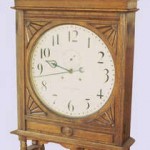Seth Thomas (1786-1859) became an apprentice in the cabinetmaker-joiner trade in the early 1800s. He worked with Silas Hoadley around 1808 to 1810, under the supervision of Eli Terry near Waterbury, Connecticut. Eli Terry needed help to fulfill a contract for four thousand wooden hang-up clocks, including their movements, pendulums, dials, and hands. Thomas, as a joiner, assembled the clocks using his wood-working techniques. All clocks were in running order when he finished.
In 1810, Seth Thomas and Silas Hoadley bought Eli Terry’s plant. They made tallcase clocks and thirty-hour clocks with wooden movements. In 1813, Seth Thomas sold his share of the business to Silas Hoadley and bought a shop in Plymouth Hollow, Connecticut, where he made tall-case clocks with wooden movements. This shop remained his workplace until 1853.
In 1839, Seth Thomas changed from using wooden to thirty-hour brass clock movements, and in about 1850 he began using springs instead of weights to power his clocks.
Seth Thomas “18 Inch Lobby” oak wall clock, second hand,, incised carving, lever movement, 15-day, time only, 25 x 38″ h. $2,500.
Thomas, who was primarily known for clock making, was also known as a good businessman. He diversified his financial interests and acquired a considerable amount of farmland. In the early 1800s at the age 48, he bought a cotton factor}’, which he operated profitably until the Civil War began in 1861. By 1844, he had stopped making wooden clocks. As a traditionalist he was reluctant to change his clockmaking methods, but producing brass clocks was more profitable. Thomas’ company was soon producing twenty thousand brass clocks annually. At the height of his brass clock production, he built a brass rolling mill called the Thomas Manufacturing Company.
From 1853 to 1865, the Seth Thomas Clock Company operated in Plymouth Hollow7. After Thomas’ death in 1859, his three sons—Aaron, Edward, and Seth Junior—carried on the business, creating many new models of spring-driven clocks. In addition, calendar clocks became an important part of their line.
The residents of Plymouth Hollow respected Seth Thomas for the industries he established in the town. To show their appreciation, the town was renamed Thomaston six years after his death.
In the 1880s, the Seth Thomas Clock Company employed about 825 people. Over seventy of them were children. The workers put in a ten-hour workday and were paid from $1.50 to $3.00 a day. Skilled mechanics were at the top of the pay scale, while laborers were at the bottom. With this staff, the company produced approximately $729,000 in clocks annually.
The Seth Thomas Company, in the hands of family members, remained a success. It holds the distinction of being the longest established American clock making company. Seth Thomas profited from his leadership abilit% becoming one of the wealthiest men in Connecticut by the time he died in 1859.
In 1879, the Seth Thomas Clock Company and Seth Thomas Sons & Company consolidated. In 1931 the Seth Thomas Clock Company became a division of General Time Corporation. Seth Thomas’ great-grandson, Seth E. Thomas Jr., was chairman of the board until his death in 1932. The company’s leadership then passed out of the family’s hands and in 1970 became a division of Talley Industries.

